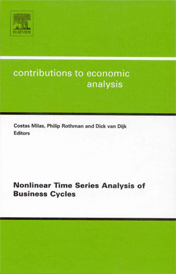Nonlinear Time Series Analysis of Business Cycles
Costas Milas, Philip Rothman, Dick van Dijk and David Wildasin
 The business cycle has long been the focus of empirical economic research. Until recently statistical analysis of macroeconomic fluctuations was dominated by linear time series methods. Over the past 15 years, however, economists have increasingly applied tractable parametric nonlinear time series models to business cycle data; most prominent in this set of models are the classes of Threshold AutoRegressive (TAR) models, Markov-Switching AutoRegressive (MSAR) models, and Smooth Transition AutoRegressive (STAR) models. In doing so, several important questions have been addressed in the literature, including:
The business cycle has long been the focus of empirical economic research. Until recently statistical analysis of macroeconomic fluctuations was dominated by linear time series methods. Over the past 15 years, however, economists have increasingly applied tractable parametric nonlinear time series models to business cycle data; most prominent in this set of models are the classes of Threshold AutoRegressive (TAR) models, Markov-Switching AutoRegressive (MSAR) models, and Smooth Transition AutoRegressive (STAR) models. In doing so, several important questions have been addressed in the literature, including:
1. Do out-of-sample (point, interval, density, and turning point) forecasts obtained with nonlinear time series models dominate those generated with linear models?
2. How should business cycles be dated and measured?
3. What is the response of output and employment to oil-price and monetary shocks?
4. How does monetary policy respond to asymmetries over the business cycle?
5. Are business cycles due more to permanent or to transitory negative shocks?
6. Is the business cycle asymmetric, and does it matter?
Accordingly, we have compiled and edited a book for the Elsevier economics program comprising 15 original papers on these and related themes.
Contents
Introduction.
1. Dating business cycle turning points (M. Chauvet, J.D. Hamilton)
2. Combining predictors & combining information in modelling: forecasting U.S. recession probabilities and output growth (M.P. Clements, A.B.C. Galvo)
3. The importance of nonlinearity in reproducing business cycle features (J. Morley, J. Piger)
4. The vector floor and ceiling model (G. Koop, S.M. Potter)
5. A new framework to analyze business cycle synchronization (M. Camacho, G. Perez-Quiros)
6. Non-linearity and instability in the EURO area (M. Marcellino)
7. Nonlinear modelling of autoregressive structural breaks in some US macroeconomic series (G. Kapetanios, E. Tzavalis)
8. Trend-cycle decomposition models with smooth - Transition parameters: Evidence from US economic time series (S.J. Koopman, K.M. Lee, S.Y. Wong)
9. Modeling inflation and money demand using a fourier-series approximation (R. Becker, W. Enders, S. Hurn)
10. Random walk smooth transition autoregressive models (H. Anderson, C.N. Low)
11. Nonlinearity and structural change in interest rate reaction functions for the U.S., U.K. and Germany (M. Kesriyeli, D. Osborn, M. Sensier)
12. State asymmetries in the effects of monetary-policy shocks on output: Some new evidence for the EURO-area (J.J. Dolado, R.M. Dolores)
13. Non-linear dynamics in output, real exchange rates and real money balances: Norway, 1830-2003 (Q.F. Akram, ?. Eitrheim, L. Sarno)
14. A predictive comparison of some simple long memory and short memory models of daily U.S. stock returns, with emphasis on business cycle effects (G. Bhardwaj, N.R. Swanson)
15. Nonlinear modeling of the changing lag structure in US housing construction (C.M. Dahl, T. Kulaksizoglu).
Bibliographic & ordering Information
Hardbound, ISBN: 0-444-51838-X, 460 pages, publication date: 2006
Imprint: ELSEVIER
Price:
EUR 105
USD 116
GBP 72


